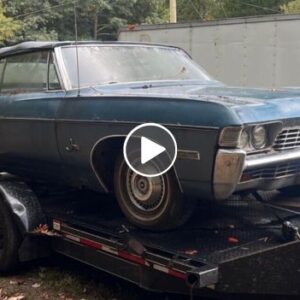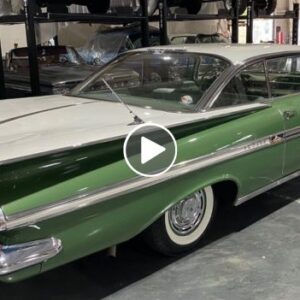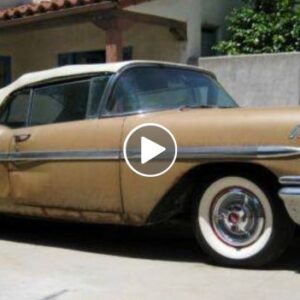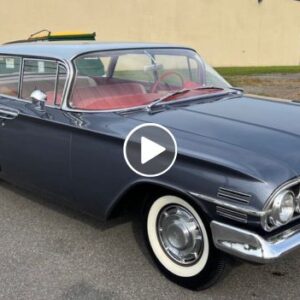There were a total of 21,380 Thunderbirds produced in 1957. This stunning example is 1 of only 196 “F-Code” Phase II supercharger equipped versions made available to the general public. The dazzling fit and finish of the exterior, engine bay and “jewel like” underside prompted a MCACN judge to comment, “it was difficult to find point deductions other than some dust”. The car scored 996/1000. After gazing on its mirror like Raven Black finish with contrasting White Colonial Vinyl interior it is not hard to understand why Raven Black was the second most popular color in ‘57. With sparkling Turbine wheel covers (wire wheels were not on the option list for the early birds) it is restored to original in keeping with the Ford Factory Invoice. Displayed with either the standard “port hole” hard top or optional soft top, its captivating beauty is matched by performance with the installation of the Supercharged 312 Y-Block V8, factory “under” rated at a whopping 300 HP. On this original drivetrain bird, the exhaust passes thru a brushed stainless steel system with integrated bumper outlets.
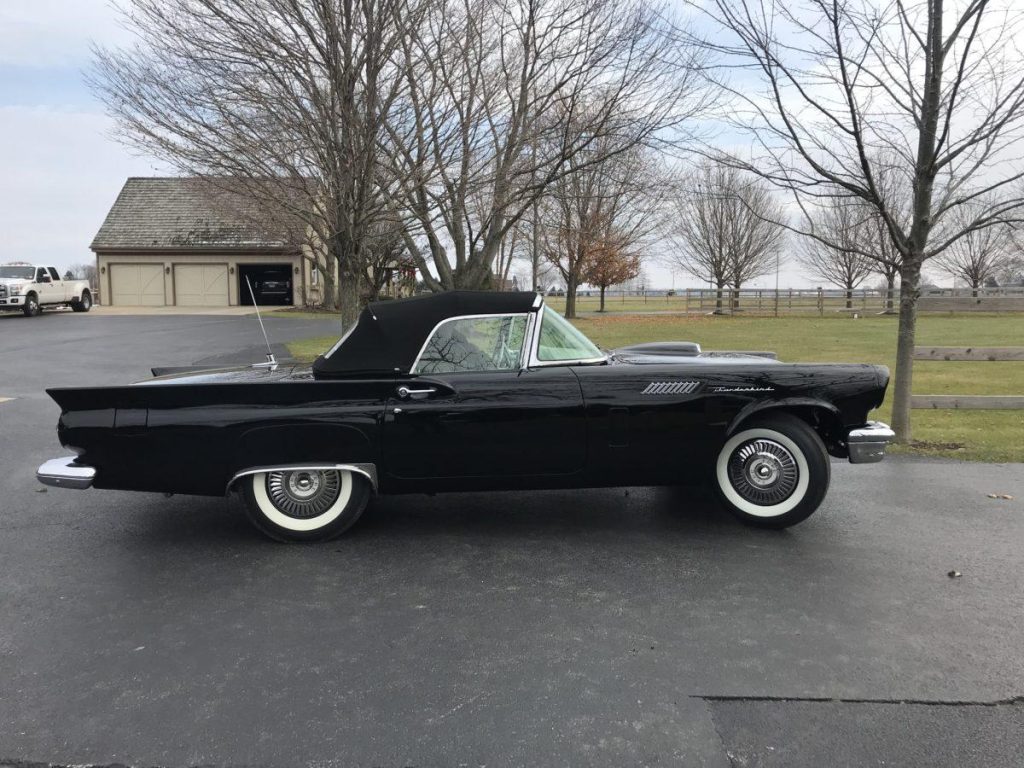
The first Thunderbirds fitted with the “F-Code” supercharged engines hit the streets sometime in the middle of June 1957. The chance of seeing one of these rare birds “in the wild” among the crowd of 21,380 T-Birds assembled in 1957 was and is somewhat remote. According to the original Ford Factory Invoice, assembly of this bird took place at the Ford plant in Dearborn, MI on November 11, 1957 where it was stamped with unit number 394855. This was very close to the December 13, 1957 end of the production run for the first series two seat Thunderbirds.

It was shipped to the famous Les Bacon and Son’s Ford dealership (dealer #718019), 1200 Pacific Coast Hwy, Hermosa Beach, CA. Lester C. Bacon and his talented wife Marion S. Bacon were the owners and founders of Les Bacon and Sons Ford. While Les sold cars to Marilyn Monroe, Anne Bancroft, and other Hollywood “stars”, Marion was talented in her own right, ghost writing for Mary Pickford and appearing in many of her movies. The Bacon Ford dealership is both interesting and historically significant. From 1949 to 1963 it was a landmark located at the corner of Aviation Boulevard and Pacific Coast Highway in Hermosa Beach. With extravagant commercials and the use of exotic animals, celebrities and animated commentary, it became one of the largest Ford dealers west of the Mississippi, selling something like 500 cars a month. Their advertising antics included a cigar-smoking ape named Robert, after one of Les’s two sons, who appeared to drive a Thunderbird across the car lot. Actually, the creature would steer while an employee lying on the floor operated the brake and accelerator. “Robert’s gone ape over Thunderbirds,” Roger Bacon would tell viewers.

The Ford Factory Invoice supplied by Classic Thunderbird Club International (CTCI) has an invoice date of 11-09-1957 with production scheduled for 11-11-1957 (11 Y). According to a copy of the earliest California title, Lydia Semenuk was possibly the first owner. Lydia lived in Carson, CA at the time, a small community close to Hermosa Beach. It was probably Lydia who changed the color to white with a red interior from its original black with white interior. She sold the car in 1987. Ron and Mike Pavlak acquired the car from the second owner in 2000. Apart from the color change the car was in remarkable condition. It still retained the original drivetrain and was rust free. Mike verified and authenticated the date codes and numbers on all the critical engine and driveline components. The car was disassembled, parts were refinished or replaced with NOS pieces in Mike’s shop by Dave Faitz an expert builder with long history of restoring award winning Thunderbirds. The entire drive train including the rear axle was reconditioned and rebuilt in Mikes shop. The supercharger work was done by Jim Weatherly in Fullerton, CA. The body was refinished in the original Raven Black and the interior retrimmed in the original pleated Colonial White Vinyl. It is fitted with the very rare and desirable McCulloch Supercharger Gauge set. In August of 2018 the restoration was complete and on November 21, 2018 Ken Nagel became the next caretaker of this very rare “F” Code Thunderbird.

According to the documented F-Bird history supplied by historians John Shields and Frank Stubbs the first supercharged Thunderbirds were all built on January 25, 1957 with VIN numbers beginning with “D”, these cars were referred to as Phase I “D/F” cars. “There were 15 D/F’s, also called Phase One and 196 Phase Two “F-Birds” from F7FH310743 to F7FH395670. The VIN numbers were sequenced in with the rest of the Ford models and not unique to the Thunderbirds. Ken’s number 394855 is toward the end of the T-Bird production run”. John said, “I have the numbers for all 211 supercharged cars and the dealers to which they were delivered. Of the 156 cars I know that still exist I have data plate numbers and copies of 126 of their invoices so far.” It is estimated that as few as 40 of these cars have been restored to original and are in running condition. The last Phase I was number D7FH202195.

It is well to remember that the reason for strapping a blower on the 312 Y Block in the first place was to homologate the engine for NASCAR racing. Ford was getting clobbered by Oldsmobile and Pontiac with their triple two barrel “J-2 and Tri Carb” carburetor set ups and by Chevrolet with its new Rochester mechanical fuel injected 283 Cu In V8. So, “Ford had a better idea” and with the help of Holman Moody bolted a VR57 Paxton-McColloch blower to the 312 V8 that pumped compressed air into the specially pressurized Holly 4bbl carburetor. And there you have it, a simple and reliable way to get 300+ HP.

The “supercharged” engine option with the VR57 supercharger delivering five pounds of boost was available to Ford car buyers as a factory performance option on any ’57 Ford or Thunderbird. The VIN numbers began with “F” on the 196 Phase II cars, hence the “F Code” nickname. It is estimated that something like 974 “F” Code engines were installed in various size Fords, including 17 Ford Fairlane 500 Skyliners (retractables), one of which is in Ken’s collection. It’s worth noting that the only difference in the supercharger installations between the Thunderbird and full size Fords was the location of the air cleaner. On full size Fords it was located high on the driver’s side of the engine compartment and on the Thunderbirds, it was located on the passenger side below the heater blower toward the firewall.

The Supercharged 312 Cu In V8 with 4bbl Holly carburetor was available at a factory invoice price of $340. To extract the full benefit of supercharging, it was necessary to reinforce the 312 V8’s cylinder heads, modify the combustion chambers with a lower compression 8.5:1 ratio and install a dual-point distributor. Certain models also had a hotter camshaft of 290 degrees duration versus the stock unit of 256 degrees. The Supercharger is a belt driven Paxton McCulloch VR57. There were three grooves on the crank pulley. The manual transmission cars used two belts for the supercharger. With an automatic transmission, the front groove was larger and drove the super-charger with a single belt. The centrifugal type automatic ball-driven variable speed blower is lubricated with engine oil and operated by manifold vacuum. A single pressure sealed 4bbl Holly carburetor with automatic choke feeds the compressed fuel air charge to the engine. In order to deliver fuel to the carburetor fuel bowl, the fuel pump itself was modified; a metered combination of blower bleed air and carburetor vacuum pressure was injected into the atmosphere side of the fuel pump to obtain a pump pressure greater than the carburetor pressure. A supercharged Thunderbird couldn’t have gotten its gas without this positive differential. The factory horsepower rating stood at 300 HP. Interestingly enough, Paxton Products claimed that the output was actually 360 HP with the hotter cam.

With the emphasis on luxury the Thunderbird Sales Brochures, overwhelmed the “312 Supercharged V8” option with a long list of luxury features not found on the typical sports car of the day. Some of the most noteworthy are: Lifeguard steering wheel, instrument panel sun visors color keyed, looped rayon carpets, exclusive paint with a “built-in wax job!” And, a radio that automatically adjusts volume when you adjust speed. As the advertising claimed, “Thunderbird is America’s distinguished personal car

1957 was a very good year for Ford Motor Company. Ford out sold the 1957 Chevrolet models for the first time in a couple of years. Some say the margin of victory was guaranteed by the roaring success of Ford’s two seat personal luxury car, the Thunderbird? That same year the “F” code engine made the option list for the T-Bird, making the cars perform as good as they looked. The T-Bird was all the rage with its powerful V8 and its short deck, long hood classic sports car looks. It remains perhaps the most recognized of the glittering offerings from American car makers from the ‘50’s. Seen at a cruise night it usually gets “What’s that?” from the younger generation and from the older generation it always gets “Wow, a T-Bird!”. Interestingly, there was no way to tell you were looking at a supercharged “F-Bird” without looking under the hood. No exterior badging announcing the supercharged engine and looking at the dash there was no indication you were about to unleash 300 HP of supercharged “whoosh”! Some owners, however, elected to install an expensive after-market steering column mounted gauge cluster made by Paxton-McCulloch to monitor fuel flow and boost, of course that was a dead giveaway.

Immortalized in TV shows, songs and movies, the most memorable being the movie “American Graffiti” with Suzanne Sommers as the mysterious blond in the ’56 Colonial White T-Bird with matching porthole hard top; and songs like the Beach Boys “Fun Fun Fun”, that is until her daddy took the T-Bird away for going to the hamburger stand instead of the library, the “Baby Birds” left an indelible mark on automotive history. By the way, publications indicate the white T-Bird used in the movie is still alive and well in the care of its second owner in Petaluma where most of the movie was filmed. The 1957 Ford Thunderbird, like all two-seat Thunderbirds, is among the most collectible of all Thunderbirds and the ’57 Thunderbird equipped with a supercharger as a factory option, heads the list.

Lewis D. Crusoe, Frank Hershey, and George Walker are considered the creators of the Thunderbird. Crusoe was a retired GM executive; Hershey was a designer for Ford; and Walker was the chief stylist for Ford. While Crusoe and Walker were in Paris, they saw a sports car and were instantly inspired. They convinced Hershey to create designs and the result was an open car with room for two passengers. As with all cars, deciding on a suitable name was difficult. A contest with a $250 suit as the prize for the best name was held. A young stylist named Alden Giberson submitted the name “Thunderbird”, a bird from Native American mythology representing power and strength and won the suit.
Some say that Ford made the two seat Thunderbird to compete with the Chevrolet Corvette. In reality they were not the same car. The Corvette was conceived to be an all-out sports car while the Thunderbird was marketed as a Personal Luxury Sports car. For a short time, Ford along with privateers raced the cars. And they did well until Ford chief Robert McNamara pulled the plug on the racing program in 1957. A modified, blown ’Bird with a 1/4-inch stroked crank, aerodynamic light body panels and a beefed-up gearbox and rear end beat the Corvettes at the 1957 Daytona Beach, FL Speed Week Trials. It blasted through the two-way Flying Mile on the beach at 138.755 mph. And later that year, at the Bonneville speed trials, the same car topped 160 mph.
The 1957 Thunderbird was arguably the best of the T-Bird two-seaters. It had the same 102-inch-wheelbase as the Corvette and sexy Jaguar XK-140 but echoed the styling theme of full-size Fords. It had a new combination front bumper/grille and longer rear end that enclosed the spare tire. Rear fenders had modest canted fins, as did regular 1957 Fords because Ford wanted to maintain the potent Thunderbird sales influence on regular models. 1957 saw the last of the two seat models as Ford continued to develop the Thunderbird as a four door, four passenger personal luxury sporting vehicle.
The two seat “Baby Bird” was only made for three years before the marque was redesigned to appeal to the luxury four seat personal car market. A short lived revival from 2002 to 2005 yielded 68,098 two seaters, 14,932 more than made in the 50’s. Production finally ended on July 1, 2005 and the two seat Thunderbird slipped back onto the pages of automotive history for the last time.
